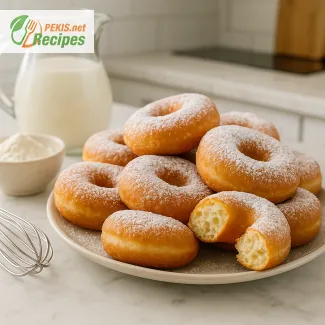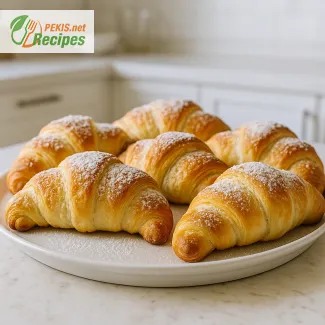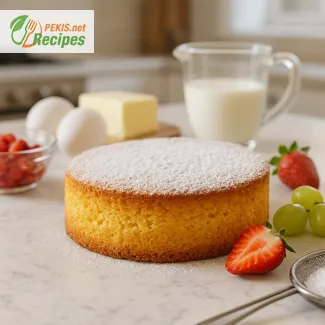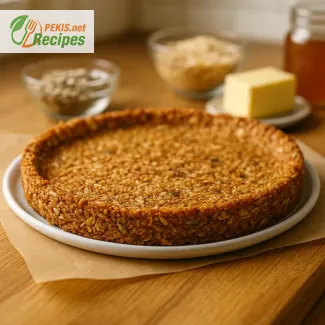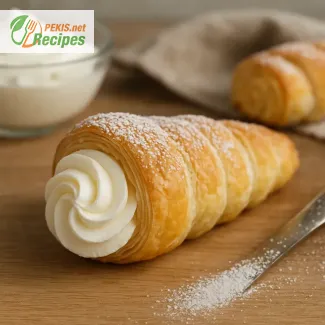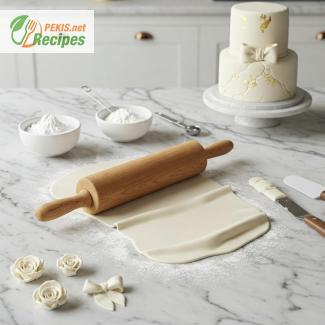
Master the Art of Homemade Fondant: A Step-by-Step Guide
What Makes Fondant So Special?
Fondant is the secret ingredient behind smooth, flawless cake designs that look straight out of a professional bakery. Whether you're decorating an elegant wedding cake, sculpting intricate figures for a birthday celebration, or covering cupcakes with a sleek finish, fondant provides an unmatched polished and professional look. Its versatility allows bakers to create breathtaking decorations, from delicate flowers to three-dimensional cake toppers.
For those who love baking, making fondant from scratch is a game-changer. Store-bought fondant often lacks the soft texture and delicious flavor that a homemade version provides. Many commercial fondants are overly stiff, too sweet, or difficult to work with, but a homemade recipe ensures a pliable, easy-to-roll fondant that melts in your mouth.
The Benefits of Making Your Own Fondant
Creating fondant at home may seem daunting at first, but once you try it, you'll never go back to store-bought alternatives. There are numerous advantages to preparing your own fondant:
- Better Taste – Unlike store-bought versions, homemade fondant has a pleasant, mild sweetness without an overpowering artificial flavor.
- Easier to Work With – Many commercial fondants can be dry, brittle, or difficult to roll out, but a fresh batch made from scratch remains smooth and elastic.
- Customizable – You can easily adjust the consistency, flavor, and color to match any cake design. Want a hint of vanilla or almond extract? Prefer a firmer texture? You’re in complete control.
- No Unwanted Ingredients – Store-bought fondant often contains preservatives, artificial flavors, and stabilizers, while a homemade version keeps things natural and simple.
- More Affordable – High-quality fondant can be expensive, but making your own ensures a budget-friendly alternative without compromising quality.
Common Challenges When Working with Fondant
Despite its impressive qualities, fondant does require a bit of skill and patience. Many beginners encounter cracks, air bubbles, or stickiness while rolling it out. The key to success is proper kneading, the right moisture balance, and a dusting of cornstarch or powdered sugar to prevent sticking.
Some common fondant issues include:
- Dry or Cracked Fondant – This usually happens when it’s over-kneaded or exposed to too much air. Adding a small amount of vegetable shortening can restore elasticity.
- Sticky Fondant – If the fondant becomes too soft or sticky, refrigerating it for a few minutes can help firm it up.
- Air Bubbles – A small needle or pin can be used to gently release trapped air before smoothing the surface.
- Tearing or Ripping – Rolling fondant too thin or using too much powdered sugar can cause tears. The key is maintaining a balanced consistency for rolling and covering cakes.
Creative Ways to Use Fondant
Fondant isn’t just for covering cakes! Once you master its smooth and pliable texture, you can use it for a variety of cake decorating techniques:
- Cake Covering – Achieve a perfectly smooth cake surface for professional-looking designs.
- Fondant Flowers – Create roses, daisies, and peonies for an elegant touch.
- Cake Toppers – Sculpt characters, figures, or themed decorations to match any occasion.
- Embossing and Texturing – Use patterned mats or stencils to add intricate details.
- Cupcake Toppers – Cut out decorative shapes and letters for personalized treats.
Essential Tips for Success
Making and using fondant doesn’t have to be intimidating! With a few pro tricks, you can create bakery-worthy designs with ease.
- Keep Your Hands and Tools Greased – Lightly coat your hands and rolling pin with a small amount of vegetable shortening to prevent sticking.
- Work in a Cool, Dry Environment – Fondant becomes sticky in humid conditions, so avoid working in a warm kitchen.
- Color in Small Batches – When tinting fondant, always start with a small amount of food coloring and gradually build up the shade.
- Let Cakes Rest Before Covering – Applying fondant directly to a warm cake can cause melting or sweating. Always allow cakes to cool completely.
- Store Properly – Wrap fondant tightly in plastic wrap and store in an airtight container to keep it fresh.
The Perfect Fondant for Every Occasion
Whether you’re making a birthday cake, wedding masterpiece, or holiday-themed desserts, homemade fondant offers endless creative possibilities. Once you’ve mastered the basics, you can experiment with different flavors, colors, and decorating styles to create stunning desserts that impress every guest.
With this easy-to-follow recipe, you’ll be able to create a silky, smooth fondant that transforms any homemade cake into a professional-looking showpiece. Ready to get started? Let’s make fondant from scratch!
- Dissolve the gelatin: In a small bowl, combine gelatin powder with cold water. Let it sit for 5 minutes until it blooms.
- Melt the gelatin mixture: Place the bloomed gelatin in a heatproof bowl and set it over a saucepan with simmering water. Stir until completely dissolved.
- Add liquid ingredients: Stir in glucose syrup, glycerin, and butter. Mix until the butter melts and everything is well combined. Remove from heat and add vanilla extract.
- Prepare the powdered sugar: In a large mixing bowl, sift the powdered sugar to remove lumps. Make a well in the center.
- Combine wet and dry ingredients: Gradually pour the gelatin mixture into the well, stirring with a spatula until the mixture starts to come together.
- Knead the fondant: Transfer the mixture onto a clean surface dusted with powdered sugar. Knead gently until it becomes smooth and pliable.
- Store properly: Wrap the fondant in plastic wrap and place it in an airtight container. Let it rest at room temperature for at least an hour before using.
Elevate Your Fondant: Expert Tips for a Perfect Homemade Version
The Key to Perfect Fondant Texture
Creating smooth, pliable fondant is essential for achieving professional-looking cakes. Many store-bought versions tend to be too stiff or overly sweet, which can make cake decorating frustrating. By fine-tuning a homemade fondant recipe, you can enhance both texture and flavor, ensuring a delightful experience from preparation to final presentation.
To achieve the perfect consistency, consider adjusting the balance of gelatin, glycerin, and glucose syrup. If the fondant is too dry or cracks easily, increasing the glycerin will add elasticity. Conversely, if the fondant feels sticky, a small amount of extra powdered sugar or cornstarch can improve its workability.
A good kneading technique also plays a crucial role. Over-kneading can lead to tough and dry fondant, while under-kneading results in uneven elasticity. The best approach is to knead gently until the fondant becomes smooth and flexible, ensuring it rolls out effortlessly.
Enhancing the Flavor of Fondant
One common complaint about traditional fondant is its overpowering sweetness and lack of depth in flavor. By incorporating natural extracts and alternative sweeteners, you can transform standard fondant into a more refined and enjoyable component of your cake.
- Vanilla extract – Adds warmth and enhances the overall sweetness.
- Almond extract – Introduces a subtle nuttiness that balances sugar intensity.
- Lemon or orange zest – Provides a hint of citrus, cutting through excess sweetness.
- Cocoa powder – Perfect for creating a chocolate fondant with a richer taste.
- Salt – A small pinch enhances flavors and reduces excessive sweetness.
If you prefer a less sweet fondant, replacing some of the powdered sugar with alternative natural sweeteners like honey, agave syrup, or maple syrup can work well. However, this requires adjusting the moisture balance to maintain the correct fondant texture.
Common Mistakes and How to Avoid Them
Even experienced bakers can face challenges when working with fondant. Understanding common pitfalls ensures a smooth and stress-free decorating process.
- Overly dry fondant – Caused by too much powdered sugar or prolonged air exposure. Solution: Add a few drops of vegetable shortening and knead gently.
- Fondant tearing while rolling – This happens when fondant is too thin or dry. Solution: Keep fondant at 3-5 mm thickness and ensure it's well-kneaded before rolling.
- Sticky fondant – Often due to excess humidity or high temperatures. Solution: Lightly dust your workspace with cornstarch or powdered sugar and work in a cool environment.
- Uneven color distribution – When adding food coloring, knead thoroughly to achieve an even hue without streaks. Gel-based colors work best for vibrant results.
- Sweating fondant – Occurs when stored in the refrigerator and exposed to humidity. Solution: Always store fondant at room temperature in an airtight container.
Healthier Alternatives for a Guilt-Free Fondant
Traditional fondant is often high in sugar and artificial additives. If you're looking for a healthier alternative, consider these options:
- Marzipan – Made with ground almonds and honey, this offers a more natural, nutrient-dense alternative.
- Coconut Fondant – Using coconut butter and natural sweeteners provides a softer, dairy-free option.
- Agar-Agar Based Fondant – Ideal for vegan-friendly cakes, replacing gelatin with plant-based agar-agar.
- Reduced-Sugar Fondant – Substituting part of the powdered sugar with erythritol or monk fruit sweetener maintains sweetness while lowering the calorie content.
Why Homemade Fondant is Superior to Store-Bought
Many commercial fondants contain preservatives, stabilizers, and artificial flavors that compromise quality. A homemade version allows for:
- Better taste – No artificial aftertaste, just fresh, natural sweetness.
- Adjustable consistency – Customize texture based on humidity and cake type.
- No unnecessary additives – Avoid chemical preservatives for a cleaner recipe.
- Cost efficiency – Store-bought fondant can be expensive, whereas homemade is budget-friendly.
Creative Ways to Use Fondant Beyond Cakes
Fondant isn't just for covering cakes! Its versatile nature allows for numerous decorative and artistic applications:
- Sculpting edible figures – Create custom characters, flowers, and bows.
- Embossed and textured patterns – Use silicone mats or stencils for elegant cake designs.
- Themed cookies and cupcakes – Cut out shapes and letters for personalized treats.
- Fondant ribbons and braiding – Ideal for wedding cakes or special occasion designs.
By perfecting the texture, flavor, and handling of fondant, you can elevate your baking skills to new heights. A well-crafted fondant adds elegance and creativity to cakes, ensuring a stunning final presentation with every bake.
- This recipe contains gelatin (animal-based) and dairy (butter).
- It is gluten-free but may not be suitable for vegetarians due to gelatin.
Substitution Tips for Allergens and Gluten:
- Replace gelatin with agar-agar (5 g / 2 tsp) dissolved in warm water for a vegetarian-friendly version.
- Substitute butter with vegetable shortening or coconut oil for a dairy-free alternative.
- Calcium (2 mg per serving): Supports bone health.
- Iron (0.1 mg per serving): Essential for oxygen transport in the blood.
- Magnesium (1 mg per serving): Contributes to muscle and nerve function.
- Vanilla extract (0.5 mg polyphenols per serving): Contains natural antioxidants that help reduce oxidative stress.
- Cornstarch (trace amounts of flavonoids): Provides minor antioxidant benefits.
